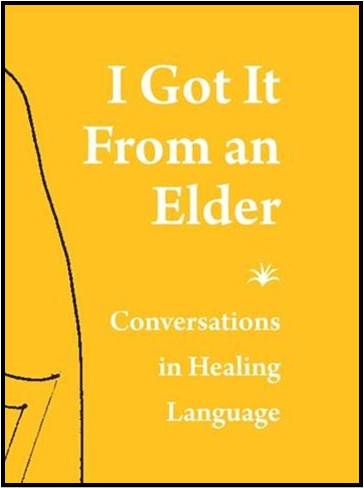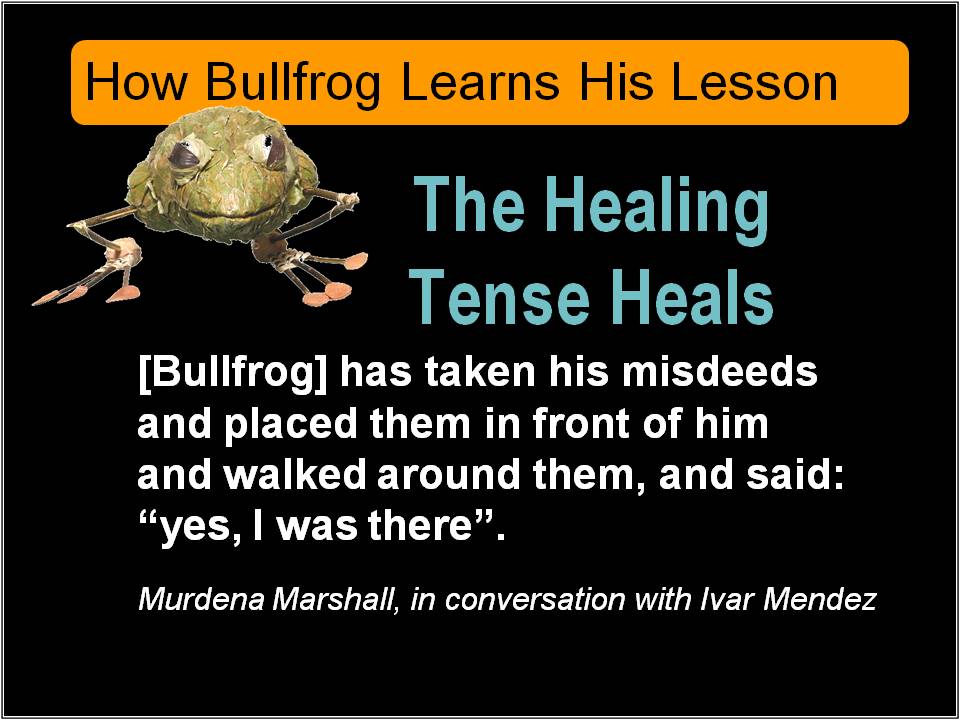Healing
 Healing as a Guiding Principle we attribute to Mi'kmaw Elder Murdena Marshall.
Healing as a Guiding Principle we attribute to Mi'kmaw Elder Murdena Marshall.
Participants in the Integrative Science co-journey have been provided with traditional understandings and guidance with respect to healing by Elder Murdena starting in about 2003 when she began to bring forward her understandings about the "healing tense" within the Mi'kmaw language. Murdena indicates that this verb tense requires a person to put his/her deeds out in front of him/herself like an object, to take ownership over them, to be able to say "that's me" within a consciousness of transformation and acceptance.
Healing words and healing actions are exceedingly important whenever and wherever integrative work is attempted. By definition, integrative work involves collaboration among two or more epistemic communities (Winder 2005), as for example by people who come from different cultures and/or different worldviews. Such work can easily but unwittingly find itself dealing with many repercussions of bygone, painful events. For example, in Canada the historical record is one of grave injustice towards Aboriginal peoples and societies. It is our fervent desire in Integrative Science to avoid contributing new misunderstandings.
Integrative Science research on the Healing Tense
In Winter 2005, Elder Murdena spent an entire weekend at her home in Eskasoni First Nation discussing the healing tense with Dr. Ivar Mendez, a leading neuroscientist at the Brain Repair Centre in Halifax, Nova Scotia, Canada. Later, Integrative Science Post-Doctoral Fellow then Research Fellow Dr. Marilyn Iwama worked with the audio tapes of these discussions and then spent many additional hours discussing the healing tense with Murdena; she then worked these efforts into two key publications.
In Marilyn's first publication (Iwama et al. 2007) ... which is the chapbook I Got It  From An Elder; conversations in healing language published by Gaspereau Press ... these words by Murdena are found: "You have to take full responsibility of your actions. See, in the Mi'kmaw world you have to give recognition to everything. Misdeeds good deeds past deeds. You know? Anything. You have to give that acknowledgment. Everything that you do, you have to acknowledge it. And the listener, if he's a Mi'kmaw speaker, will understand at which state of reality are you in. Healed in a way that you're back. Reinstated into the family. If you don't go into that tense you cannot heal, you will not have healed."
From An Elder; conversations in healing language published by Gaspereau Press ... these words by Murdena are found: "You have to take full responsibility of your actions. See, in the Mi'kmaw world you have to give recognition to everything. Misdeeds good deeds past deeds. You know? Anything. You have to give that acknowledgment. Everything that you do, you have to acknowledge it. And the listener, if he's a Mi'kmaw speaker, will understand at which state of reality are you in. Healed in a way that you're back. Reinstated into the family. If you don't go into that tense you cannot heal, you will not have healed."
In a second publication (Iwama et al. 2009) ... which is an article in the Canadian Journal of Native Education ... more of Murdena's thoughts and Marilyn's insights about healing words and actions can be found.
Marilyn and Murdena also worked to modify the ending for the Mi'kmaw legend How Bullfrog Learns His Lesson. In the modification, Bullfrog realizes that he has brought misery to the lives of others and repents of his actions ... and he employs the healing tense when he speaks about his misdeeds. This ending was  then incorporated into puppetry enactments of the legend and performed by students in the first year MS
then incorporated into puppetry enactments of the legend and performed by students in the first year MSITclasses in the Integrative Science academic program at Cape Breton University. The students performed for a select few audiences, including children in elementary schools and adult participants at a community workshop on collaborative environment planning. Marilyn also spoke about this work on the healing tense and its incorporation into puppetry in conjunction with student research assistants Carola Knockwood and Natalie McEwan at the 2005 Canadian Aboriginal Science and Technology Society (CASTS) national conference held in Sydney and Membertou First Nation.
Elder Murdena's understandings as to what the Mi'kmaw language requires and provides via the healing tense resonate profoundly with what Ermine (2007) indicates is urgently required if reconciliation is to occur via inter-cultural dialogue and what he suggests can be provided by the concept of ethical space. We suggest, therefore, that the first phase of entering ethical space for the purpose of reconciling our scientific knowledges and ways of knowing includes learning to appropriately, correctly, and respectfully acknowledge the "that's me" and the "that's you" of our worldviews, as they configure our sciences. In this regard, we have developed tools that enable us to recognize the philosophies at play in our science stories.
References in above:
Ermine, W. (2007). The ethical space of engagement. Indigenous Law Journal, 6(1), 193-203.
Iwama, M., Marshall, M., Marshall, A., Mendez, I., and Bartlett, C. (2007). I Got It From An Elder; conversations in healing language. No. 20, Devil's Whim Occasional Chapbook Series. Kentville, NS: Gaspereau Press.
Iwama, M, Marshall, M., Marshall, A. and Bartlett, C. (2009). Two-Eyed Seeing and the Language of Healing in Community-Based Research. Canadian Journal of Native Education, 32, 3-23.
Winder, N. (2005). Integrative research as appreciative system. Systems Research and Behavioral Science, 22(4), 299-309.
Also see: Bartlett et al. (forthcoming). Integrative Science and Two-Eyed Seeing: Enriching the Discussion Framework for Healthy Communities (authors' final revised draft); Chapter 3 for book "Beyond Intractability: convergence and opportunity at the interface of environmental, health and social issues" edited by Lars K. Hallstrom, Nicholas Guehlstorf, and Margot Parkes (forthcoming). UBC Press.
